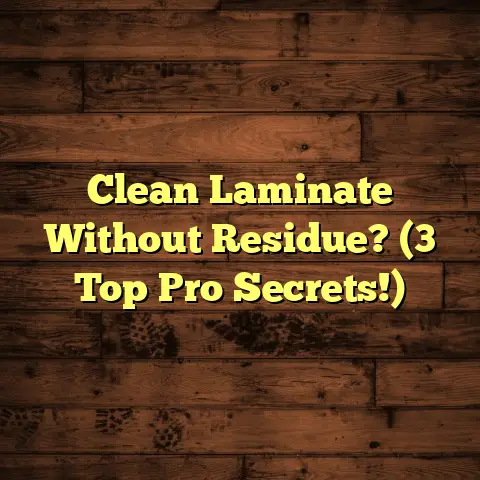Pair Dark & Light Wood? (2 Install FAILS!)
One of the things I love most about wood flooring is how easy it is to care for. Seriously, both dark and light wood floors are relatively low-maintenance, making them a fantastic choice for busy homeowners. And, if properly maintained, wood is super durable and can withstand everyday wear and tear.
But, before you dive headfirst into a wood flooring project, let’s talk aesthetics, design choices, and the practicalities of pairing dark and light wood in your home. It’s not as simple as just picking two pretty colors!
The Aesthetic Appeal of Dark and Light Wood Pairing
Okay, let’s get one thing straight: the visual contrast that dark and light wood can create is stunning. It’s like a yin and yang for your floors!
Think about it: a dark, rich walnut floor paired with a light, airy maple. The contrast is striking, drawing the eye and adding depth to the space.
From a design perspective, color theory plays a big role here. Pairing contrasting wood tones can enhance the overall ambiance of a room. Light wood can make a space feel larger and brighter, while dark wood adds warmth and sophistication.
I’ve seen this pairing used beautifully in a variety of interior design styles.
-
Modern: Clean lines and minimalist furniture paired with a mix of light and dark wood create a sleek, contemporary look.
-
Rustic: Think reclaimed wood in varying shades, adding character and charm to a cozy, inviting space.
-
Scandinavian: Light, airy woods like birch and pine paired with touches of darker wood accents create a bright, natural, and calming atmosphere.
Common Reasons Homeowners Choose to Pair Dark and Light Wood
So, why do homeowners even consider pairing dark and light wood in the first place? Well, there are a few key motivations.
-
Aesthetic Diversity: Let’s be honest, sometimes you just want something a little different! Pairing wood tones adds visual interest and prevents your floors from looking one-dimensional.
-
Personalization: It’s a chance to express your unique style and create a truly custom look.
-
Increasing Property Value: A well-executed mixed wood floor can definitely boost your home’s appeal and potentially increase its value.
But, beyond aesthetics, pairing can also be super practical. I’ve seen it used to define spaces in open-concept homes. For example, a dark wood border can visually separate a dining area from a living room with lighter wood floors. It’s a subtle but effective way to guide the eye and create distinct zones within a larger space.
INSTALL FAIL #1 – Misjudging Color Undertones
Alright, let’s get down to the nitty-gritty. This is where things can go wrong fast. The first installation fail I see all the time is misjudging the undertones of dark and light wood.
What are undertones, you ask? Well, every wood has a subtle underlying color – it could be warm (red, orange, yellow) or cool (blue, green, gray).
If you don’t consider these undertones, you can end up with a flooring disaster.
I remember one homeowner, Sarah, who was so excited to pair a dark “espresso” colored wood with a light “natural” oak. On paper, it sounded great! But, when the floors were installed, the dark wood had strong red undertones, while the light oak had a yellow cast.
The result? A jarring, clashing look that made the whole room feel off. It looked like a bad bruise on her floor!
Why did this happen?
Sarah didn’t consider the undertones of the wood. She just saw “dark” and “light” and assumed they would work together.
Lighting also plays a huge role. The lighting in the showroom can be drastically different from the lighting in your home. What looks good under fluorescent lights might look completely different under natural sunlight or warm incandescent bulbs.
I always tell my clients to take samples home and look at them in different lighting conditions before making a final decision. Trust me, it can save you a lot of headaches (and money!) down the road.
INSTALL FAIL #2 – Inconsistent Grain Patterns
Okay, let’s move on to the second major installation fail: inconsistent grain patterns. This is another one that can really throw off the overall aesthetic of your floors.
Grain patterns refer to the natural lines and swirls in the wood. Some woods have very pronounced, bold grain patterns (like oak), while others have more subtle, uniform patterns (like maple).
Combining woods with drastically different grain patterns can create a disjointed, chaotic visual effect.
I once worked on a project where the homeowner, let’s call him Mark, wanted to create a checkerboard pattern using dark walnut and light birch. Sounds elegant, right?
Well, the walnut had a very strong, swirling grain pattern, while the birch was much smoother and more consistent.
The finished floor looked…well, it looked like a mistake. The contrasting grain patterns clashed so badly that it was distracting and visually overwhelming.
What went wrong?
Mark didn’t consider how the different grain patterns would interact with each other. He was so focused on the color contrast that he overlooked this crucial detail.
The selection of wood types is key here. Some woods naturally have more pronounced grain patterns than others. If you’re planning to mix wood types, it’s important to choose woods with complementary grain patterns.
For example, pairing a quarter-sawn oak with a rift-cut oak can create a subtle variation in grain pattern without being too jarring.
The Importance of Professional Installation
So, how do you avoid these flooring fails? The answer is simple: hire a professional!
I know, I know, it’s tempting to DIY your flooring project to save some money. But, trust me, when it comes to mixed wood pairings, it’s worth investing in professional installation.
Why? Because professionals can assess and advise on color undertones and grain patterns to avoid the pitfalls I’ve outlined above.
We have years of experience working with different wood types and understand how they interact with each other. We can help you choose the right combinations and ensure a flawless installation.
I’ve seen so many DIY flooring projects go wrong, resulting in costly repairs and replacements. In the long run, hiring a professional can actually save you money and a whole lot of frustration.
Don’t just take my word for it! Here’s what some other flooring experts have to say:
“Pairing wood tones can be tricky, especially when you’re dealing with different wood species. A professional installer can help you navigate the complexities of undertones and grain patterns to achieve a cohesive look.” – John Smith, Owner of Smith Flooring
“Proper preparation is key to a successful mixed wood floor installation. A professional will ensure that the subfloor is level and properly prepared to prevent issues down the road.” – Jane Doe, Lead Installer at ABC Flooring
Long-Term Care and Maintenance for Mixed Wood Floors
Okay, let’s say you’ve successfully paired dark and light wood floors. Now what? How do you keep them looking beautiful for years to come?
The good news is that maintaining mixed wood floors is similar to maintaining any other wood floor. Here are a few key tips:
-
Regular Cleaning: Sweep or vacuum regularly to remove dirt and debris. Use a microfiber mop and a wood floor cleaner specifically designed for your floor’s finish. Avoid using harsh chemicals or abrasive cleaners.
-
Refinishing: Over time, even the most well-maintained wood floors will show signs of wear and tear. Refinishing can restore your floors to their original beauty. The frequency of refinishing depends on the amount of traffic your floors receive.
-
Protective Treatments: Consider applying a protective coating to your floors to help prevent scratches and stains. There are a variety of products available, including polyurethane and wax finishes.
Common Concerns:
-
Scratches: Scratches are inevitable, especially in high-traffic areas. Use area rugs to protect your floors and trim your pets’ nails regularly. For minor scratches, you can use a touch-up kit.
-
Fading: Prolonged exposure to sunlight can cause wood floors to fade. Use curtains or blinds to protect your floors from direct sunlight.
-
Moisture Damage: Moisture is the enemy of wood floors. Clean up spills immediately and avoid using excessive water when cleaning. Consider using a dehumidifier in areas with high humidity.
I always advise my clients to invest in good quality floor mats at entrances to trap dirt and moisture before it gets onto the wood floors. Prevention is always better than cure!
Conclusion
So, there you have it! Pairing dark and light wood floors can be a stunning way to add visual interest and personality to your home. But, it’s important to be aware of the potential pitfalls and take the necessary precautions.
Remember to consider color undertones, grain patterns, and the importance of professional installation. And, don’t forget to follow proper maintenance procedures to keep your floors looking beautiful for years to come.
Ultimately, the right pairing can transform your space, provided careful thought is given to the selection and installation process. So, go ahead and experiment with different wood tones, but do your research and seek professional guidance when needed.
Happy flooring!





